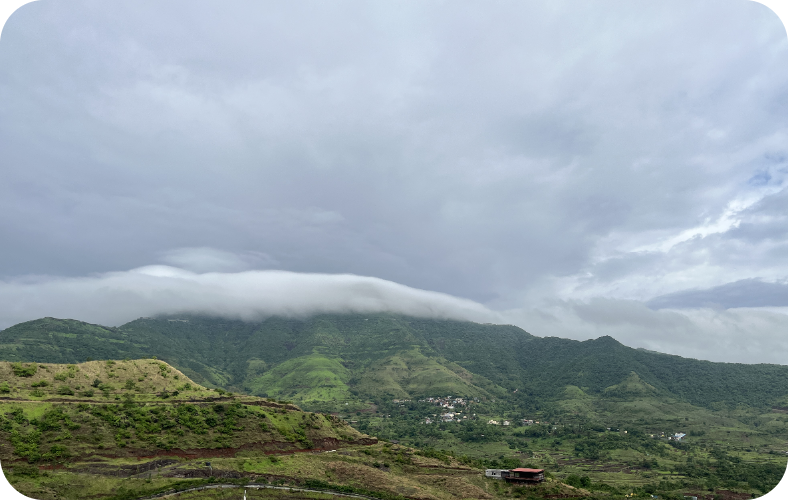
Journey Through History: The Heritage of Purandar
Nestled high in the Sahyadri Mountains of Maharashtra in Pune, Purandar Fort is a grand storyteller, whispering ballads of battles, bravery, and royal lineage. This majestic fort, standing tall at 1,374 meters above sea level, offers a glimpse into the past and invites us to explore its rich heritage. Let’s embark on a journey to uncover the historical significance of Purandar Fort and its lasting influence.
A Majestic Beginning
Purandar Fort, perched 50 kilometres southeast of Pune, is a spectacular sight. The fort is part of a pair, with Vajragad (or Rudramal) being the smaller sibling situated on a ridge to the east – one of the most iconic historical landmarks in Pune. Together, they form a powerful duo, guarding the region with their towering presence. The name “Purandar” comes from the fort’s patron deity, Purandareshwar, and has roots that stretch back to ancient times. The fort’s history is as dramatic as its setting. It was first mentioned during the Yadava dynasty, dating back to the 11th century.
In the 14th century, the Bahamani Sultans enhanced the fort’s defences with new walls and bastions. Later, in 1596, Maloji Bhosale, the grandfather of Chhatrapati Shivaji Maharaj, was granted control of the fort. But it was Shivaji Maharaj who truly made Purandar his own. In 1646, he captured the fort and established it as a stronghold of the Maratha Empire. This was just the beginning of the Purandar Fort history.
The Birthplace of a Warrior King
Purandar Fort is not only a place of military importance but also a birthplace of royalty. It was here that Chhatrapati Sambhaji Maharaj, the son of Shivaji Maharaj, was born. He went on to become the second Chatrapati of the Maratha Empire, renowned for his bravery and strategic genius. His birthplace adds a layer of deep historical significance to the fort, making it a symbol of Maratha's pride and resilience. The legacy of Purandar in Maharashtra is deeply tied to this fort and its role in shaping the region's royal heritage.
A Fortress of Legends and Battles
The fort's strategic location made it a coveted prize for many rulers. The Mughals, under Jai Singh II, besieged Purandar in 1665, leading to a fierce battle. Murarbaji Prabhu, the fort’s brave commander, fought valiantly to protect it but ultimately fell in the battle. This was a crucial moment, as Shivaji Maharaj was forced to surrender 23 forts, including Purandar, under the First Treaty of Purandar. However, in 1670, Shivaji Maharaj recaptured Purandar, reaffirming its importance in the Maratha Empire.
Purandar Fort continued to be a key player in regional politics. The British captured it in 1818 during the Second Anglo-Maratha War. The fort then served various roles, including as a prison and an internment camp during World War II. The story of Dr. Hermann Goetz, a German prisoner who studied the fort during this time, adds an intriguing chapter to its history. His research and writings have helped preserve the fort’s legacy.
Architectural Wonders and Scenic Beauty
The fort is divided into two main sections: the lower Machi and the upper Balekilla. The Machi, standing about 300 meters above the plain, houses the main gate called Delhi Darwaja and the old Kedareshwar temple. The Balekilla, the upper part, is surrounded by steep drops on three sides and offers breathtaking views of the surrounding landscape.
The fort’s sturdy walls, intricate carvings, and well-planned layout reflect the engineering skills of its builders. Walking through its corridors and climbing its steps, visitors can almost hear the echoes of the past, bringing history to life with every step.
A Living Legacy
Today, Purandar Fort is a popular destination for tourists, trekkers, and history enthusiasts. Its historical significance and natural beauty make it a captivating place to visit. The fort is also used by the National Cadet Corps for training, keeping the spirit of discipline and bravery alive.
As you stand at the base of Purandar Fort, looking up at its mighty walls and exploring its ancient pathways, you’re not just visiting a historical site. You’re stepping into a living legacy, one that tells the story of courage, royalty, and architectural brilliance. The fort stands as a proud reminder of Maharashtra’s rich history and continues to inspire all who walk its grounds.
Embrace the Legacy of Purandar
Surrounded by this rich heritage and spellbinding landscapes lies Royal Purandar, a 450-acre plotting community immersed in nature’s bounty. With ready infrastructure, a rich AQI (Air Quality Index), lower temperatures, and sustainable living; Royal Purandar heritage beholds the crown of a paradise where history and nature intertwine seamlessly.